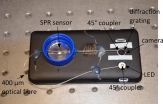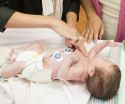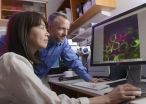(Press-News.org) Researchers at the Hanover Centre for Optical Technologies (HOT), University of Hanover, Germany, have developed a self-contained fiber optic sensor for smartphones with the potential for use in a wide variety of biomolecular tests, including those for detecting pregnancy or monitoring diabetes. The readings of the sensor can run through an application on a smartphone which provide real-time results. When properly provisioned, the smartphone-user has the ability to monitor multiple types of body fluids, including: blood, urine, saliva, sweat or breath. In case of medical applications, the sensor readings can be combined with the GPS signal of a smartphone and users can then be guided to the next drug store, hospital or the ambulance.
Described in Optics Express, a journal of The Optical Society, the sensor uses the optical phenomenon of surface plasmon resonance (SPR) -- which occurs when light causes electrons on the surface of a thin film to jostle -- to detect the composition of a liquid or the presence of particular biomolecules or trace gases.
Surface plasmon resonance occurs when a fixed beam of light strikes a metallic film; most of the light is reflected, but a small band is absorbed by the film's surface electrons, causing them to resonate. When the metallic film is placed in contact with a fluid, the index of refraction of the liquid changes the absorbed band's size and location in the light spectrum. By adding recognition elements to the film that cause a shift in the index of refraction when bound to targeted biomolecules or trace gases, scientists can thus determine important information about a biological sample's composition based on which light is reflected and which is absorbed.
"We have the potential to develop small and robust lab-on-a-chip devices for smartphones. So, surface plasmon resonance sensors could become ubiquitous now," said Kort Bremer, inventor and co-author of the new paper with Bernhard Roth, director, Hanover Centre for Optical Technologies (HOT), University of Hanover, Germany.
Surface plasmon resonance is a phenomenon commonly used for biosensing, but typically requires bulky lab equipment involving both a light detector and light source. Fortunately, smartphones already have both of these, allowing the minimalist, U-shaped device the researchers designed to consist solely of a 400-micrometer diameter core multimode fiber with a silver-coated sensing region.
In a proof-of-concept version of the sensor, Bremer carefully excised the polymer coating from a 10-millimeter segment of the optics cable to expose the bare 400-micrometer diameter glass fiber core. He then cleaned the segment, subjected it to a silver-coating process, added a small well in which to pour the solutions being observed, and polished both ends of the fiber to 45° angled faces. They were then adhered to the phone's case and, thus, to its LED and camera, the latter of which was affixed with a diffraction grating to separate the light beam into an emission spectrum.
In subsequent experiments, the device's sensitivity was tested using various concentrations of glycerol, and the team confirmed it was on par with current equipment, at a fraction of the cost and size.
INFORMATION:
Bremer and Roth acknowledge the support by the "Wege in die Forschung" grant of the Leibniz Universität, Hanover, Germany.
About Optics Express
Optics Express reports on new developments in all fields of optical science and technology every two weeks. The journal provides rapid publication of original, peer-reviewed papers. It is published by The Optical Society and edited by Andrew M. Weiner of Purdue University. Optics Express is an open-access journal and is available at no cost to readers online at: https://www.osapublishing.org.
About The Optical Society
Founded in 1916, The Optical Society (OSA) is the leading professional organization for scientists, engineers, students and entrepreneurs who fuel discoveries, shape real-life applications and accelerate achievements in the science of light. Through world-renowned publications, meetings and membership initiatives, OSA provides quality research, inspired interactions and dedicated resources for its extensive global network of optics and photonics experts. OSA is a founding partner of the National Photonics Initiative and the 2015 International Year of Light. For more information, visit: http://www.osa.org.
BOSTON - Hospitals have made significant strides to reduce or eliminate physical harm to patients since the landmark 1999 Institute of Medicine Report "To Err is Human." In a new paper published in BMJ, patient care leaders at Beth Israel Deaconess Medical Center (BIDMC) say hospitals must now devote similar attention to eliminating emotional harms that damage a patient's dignity and can be caused by a failure to demonstrate adequate respect for the patient as a person.
"Emotional harms can erode trust, leave patients feeling violated and damage patient-provider relationships," ...
LAWRENCE -- A new study that is the first to use Social Security Administration's personal income tax data tracking the same individuals over 20 years to measure individual lifetime earnings has confirmed significant long-term economic benefits of college education.
ChangHwan Kim, a University of Kansas researcher, said the research team was also able to account for shortcomings in previous studies by including factors such as gender, race, ethnicity, place of birth and high school performance that would influence a person's lifetime earnings and the probability of college ...
A study by City College of New York physicists Flaviano Morone and Hernán A. Makse suggests that "smaller is smarter" when it comes to influential superspreaders of information in social networks. This is a major shift from the widely held view that "bigger is better," and could have important consequences for a broad range of social, natural and living networked systems.
"The problem of identifying the minimal set of influential nodes in complex networks for maximizing viral marketing in social media, optimizing immunization campaigns and protecting networks under ...
ROCHESTER, Minn. - Opioid painkiller addiction and accidental overdoses have become far too common across the United States. To try to identify who is most at risk, Mayo Clinic researchers studied how many patients prescribed an opioid painkiller for the first time progressed to long-term prescriptions. The answer: 1 in 4. People with histories of tobacco use and substance abuse were likeliest to use opioid painkillers long-term.
The findings are published in the July issue of the medical journal Mayo Clinic Proceedings.
While the study identified past or present nicotine ...
Premature babies are at an increased risk for developing autism spectrum disorder. But a small study indicates that preemies who avoid eye contact in early infancy are less likely to demonstrate symptoms of autism at age 2 than preemies who maintain eye contact during early interactions, according to new research at Washington University School of Medicine in St. Louis.
"Children with autism typically have challenges with social interaction and may avoid eye contact, but it turned out that children in this study who had characteristics of autism at age 2 were more likely ...
ROSEMONT, Ill.--Participation in sports by women and girls has increased from 310,000 individuals in 1971 to 3.37 million in 2010. At the same time, sports-related injuries among female athletes have skyrocketed. According to a new study in the Journal of the American Academy of Orthopaedic Surgeons (JAAOS), women with symptoms known as the "female athlete triad" are at greater risk of bone stress injuries and fractures.
"The female athlete triad is a spectrum of symptoms that include low energy availability, menstrual cycle abnormalities, and low bone mineral density. ...
There may be far fewer galaxies further out in the universe then might be expected, according to a new study led by Michigan State University.
Over the years, the Hubble Space Telescope has allowed astronomers to look deep into the universe. The long view stirred theories of untold thousands of distant, faint galaxies. The new research, appearing in the current issue of the Astrophysical Journal Letters, however, offers a theory that reduces the estimated number of the most distant galaxies by 10 to 100 times.
"Our work suggests that there are far fewer faint galaxies ...
People have evolved to be smarter and taller than their predecessors, a study of populations around the world suggests.
Those who are born to parents from diverse genetic backgrounds tend to be taller and have sharper thinking skills than others, the major international study has found.
Researchers analysed health and genetic information from more than 100 studies carried out around the world. These included details on more than 350,000 people from urban and rural communities.
The team found that greater genetic diversity is linked to increased height. It is also ...
The European Space Agency's Rosetta spacecraft first began orbiting comet 67P/Churyumov-Gerasimenko in August 2014. Almost immediately, scientists began to wonder about several surprisingly deep, almost perfectly circular pits on the comet's surface. Now, a new study based on close-up imagery taken by Rosetta suggests that these pits are sinkholes, formed when ices beneath the comet's surface sublimate, or turn directly to gas.
The study, which appears in the July 2, 2015 issue of the journal Nature, reveals that the surface of 67P/Churyumov-Gerasimenko is variable and ...
DALLAS - July 1, 2015 - UT Southwestern Medical Center scientists collaborating with University of Michigan researchers have found a previously unidentified mechanism that helps explain why stem cells undergo self-renewing divisions but their offspring do not.
Adult stem cells provide a ready supply of new cells needed for tissue homeostasis throughout the life of an organism. Specialized environments called "niches" help to maintain stem cells in an undifferentiated and self-renewing state. Cells that comprise the niche produce signals and growth factors essential for ...



